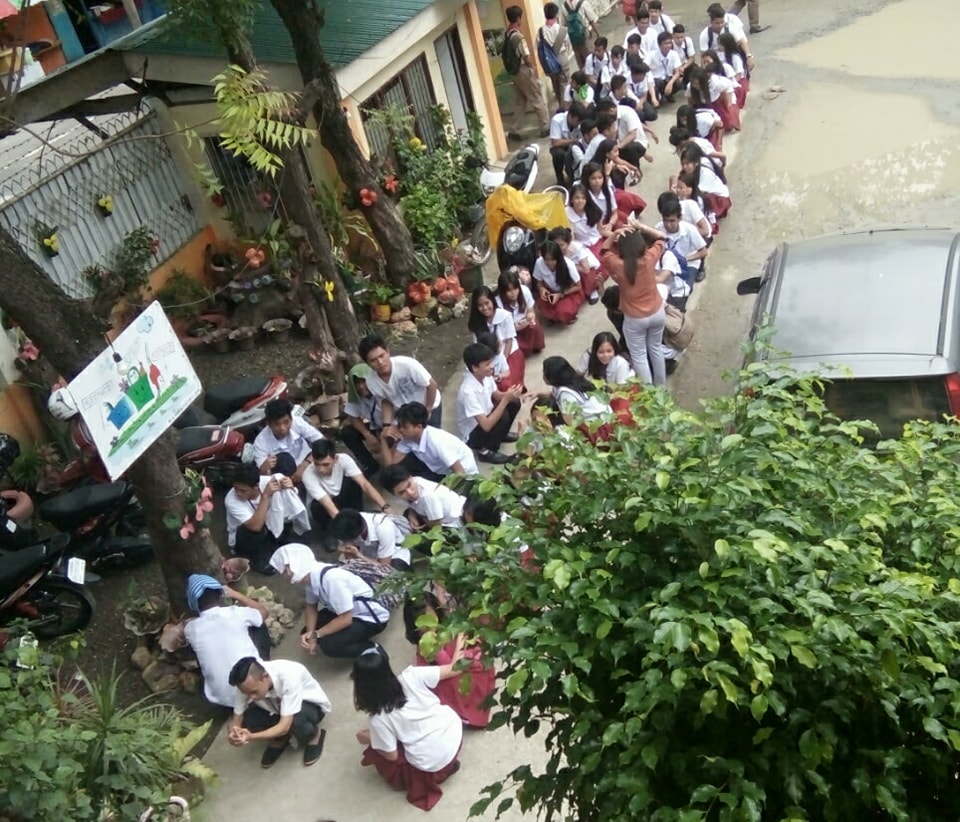Third Earthquake Drill
To prepare the students from Natural Calamities like earthquake our School conducted an earthquake drill but sad to say some of the students didn't take it seriously and even laugh at it.
According to this Information from this site we have to protect ourselves, hope these will help
https://www.shakeout.org/dropcoverholdon/
PROTECT YOURSELF. SPREAD THE WORD.
Your past experience in earthquakes may give you a false sense of safety; you didn't do anything, or you ran outside, yet you survived with no injuries. Or perhaps you got under your desk and others thought you overreacted. However, you likely have never experienced the kind of strong earthquake shaking that is possible in much larger earthquakes: sudden and intense back and forth motions of several feet per second will cause the floor or the ground to jerk sideways out from under you, and every unsecured object around you could topple, fall, or become airborne, potentially causing serious injury. This is why you must learn to immediately protect yourself after the first jolt... don't wait to see if the earthquake shaking will be strong!
In MOST situations, you will reduce your chance of injury if you:
DROP where you are, onto your hands and knees. This position protects you from being knocked down and also allows you to stay low and crawl to shelter if nearby.
COVER your head and neck with one arm and hand
If a sturdy table or desk is nearby, crawl underneath it for shelter
If no shelter is nearby, crawl next to an interior wall (away from windows)
Stay on your knees; bend over to protect vital organs
HOLD ON until shaking stops
Under shelter: hold on to it with one hand; be ready to move with your shelter if it shifts
No shelter: hold on to your head and neck with both arms and hands.
Why Drop, Cover, and Hold On? Our special report explains why official rescue teams, emergency preparedness experts, and others recommend "Drop, Cover, and Hold On" as the best way, in most situations, to protect yourself during earthquake shaking.
Wherever you are, protect yourself! It is important to think about what you will do to protect yourself wherever you are. What if you are driving, in a theater, in bed, at the beach, etc.? Step 5 of the Seven Steps to Earthquake Safety describes what to do in various situations, no matter where you are when you feel earthquake shaking.
Persons with Disabilities: See EarthquakeCountry.org/disability for recommendations for people who use wheelchairs, walkers, or are unable to drop to the ground and get up again without assistance.
Earthquake Safety Video Series: Simple videos demonstrating what to do to protect yourself in various situations (near a table, no table nearby, in a theater/auditorium, at the shore, while driving, and more to come).
Los Angeles County Firefighters demonstrate
Drop, Cover, and Hold On
Learn about Drop, Cover, Hold On from
MySafeLA.org
The main point is to not try to move but to immediately protect yourself as best as possible where you are. Earthquakes occur without any warning and may be so violent that you cannot run or crawl; you therefore will most likely be knocked to the ground where you happen to be. You will never know if the initial jolt will turn out to be the start of the big one. You should Drop, Cover, and Hold On immediately!
In addition, studies of injuries and deaths caused by earthquakes in the U.S. over the last several decades indicate that you are much more likely to be injured by falling or flying objects (TVs, lamps, glass, bookcases, etc.) than to die in a collapsed building. Drop, Cover, and Hold On offers the best overall level of protection in most situations.
As with anything, practice makes perfect. To be ready to protect yourself immediately when the ground begins to shake, practice Drop, Cover, and Hold On as children do in school at least once each year.
What NOT to do:
DO NOT get in a doorway! An early earthquake photo is a collapsed adobe home with the door frame as the only standing part. From this came our belief that a doorway is the safest place to be during an earthquake. In modern houses and buildings, doorways are no safer, and they do not protect you from flying or falling objects. Get under a table instead!
DO NOT run outside! Trying to run in an earthquake is dangerous, as the ground is moving and you can easily fall or be injured by debris or glass. Running outside is especially dangerous, as glass, bricks, or other building components may be falling. You are much safer to stay inside and get under a table.
DO NOT believe the so-called "triangle of life"! In recent years, an e-mail has circulated which recommends potentially life threatening actions, and the source has been discredited by leading experts.
Hi! I am a robot. I just upvoted you! I found similar content that readers might be interested in:
https://www.shakeoutbc.ca/dropcoverholdon/
Hello @cheetah thank you, Sorry for a very late reply, I was busy lately.God bless!